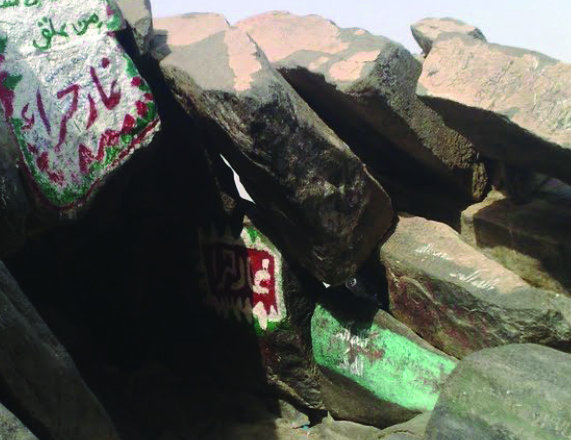
Contemplation in the Shadows of Crisis: Drawing Parallels Between Cave Hira and the Gaza Tragedy
Alameen
5-28-2025
 Email
to a friend Email
to a friend
 Post
a comment Post
a comment
 Print Print
As millions of Muslims fulfill their once-in-a-lifetime dream of performing Hajj and visiting the sacred sites in Mecca, the Cave of Hira stands as a symbol of profound spiritual awakening. Nestled in the mountains outside Mecca, this cave is where Prophet Muhammad PBUH received the first revelation of the Quran from Angel Gabriel—a pivotal moment that not only transformed his life but also reshaped human history. As the world turns its gaze to the modern-day tragedy unfolding in Gaza, the solitude of Hira offers an urgent metaphor for reflection, purpose, and moral clarity.
A Cave of Solitude and a Land Under Siege
Cave Hira was a sanctuary—void of political ambition or violence—where Prophet Muhammad PBUH sought solitude, inner clarity, and divine truth. It was here, in silence, that revelation came. Today, Gaza represents the antithesis: a land gripped by siege, reverberating with the noise of drones, bombs, and humanitarian despair.
Yet, the essence of Hira transcends its geography. It embodies a yearning for meaning amidst corruption and injustice. Just as Muhammad PBUH turned inward in a corrupted society to find truth, we are called today to question: What truths are being ignored amidst Gaza’s ruins? What divine principles are silenced by political expediency and global indifference?
Parallel Struggles: Prophet Muhammad PBUH and Gaza’s People
The challenges faced by Prophet Muhammad PBUH during his early prophetic mission resonate deeply with the struggles of Palestinians in Gaza:
•Opposition and Hostility: Muhammad PBUH faced immense hostility from his own people; similarly, the people of Gaza face sustained external aggression and isolation.
•Pursuit of Justice: His message of justice and equality echoes the aspirations of many in Gaza who seek peace, dignity, and recognition.
Muhammad’s PBUH resilience and steadfast faith highlight timeless lessons:
•Unyielding Spirit: In the face of adversity, his conviction grew stronger—reminding us that spiritual and moral fortitude can emerge even in bleak times.
•Community Strength: His solidarit with his early followers illustrates the importance of communal support and shared resolve during hardship.
Inspiring Hope and Compassion in Adversity
Prophet Muhammad’s PBUH experience offers more than historical reflection; it inspires a response grounded in hope and compassion:
•Acts of Kindness: In the face of overwhelming suffering, even small gestures—donations, advocacy, or listening—can make a difference.
•Shared Humanity: Recognizing our interconnected struggles fosters empathy and unity across divides.
These reflections challenge us not just to sympathize but to embody compassion, ensuring that hope continues to burn even in darkness.
Revelation and Responsibility
The first words revealed to the Prophet were: “Read! In the name of your Lord who created.” (Quran 96:1). It was a command not of war, but of awakening. A call to seek knowledge, uphold life, and witness truth.
As Gaza burns, this command challenges the global conscience: Are we reading the signs of our time with moral clarity? Are we responding to suffering with justice—or turning away in silence and selective outrage?
Muhammad’s PBUH initial reaction to revelation was not defiance, but awe. He sought counsel, not control. This contrasts sharply with many modern leaders whose crisis responses are shaped more by power than by principle.
Moral Contemplation in a Time of Crisis
Cave Hira represents more than a historical location—it is a metaphor for personal and collective moral awakening. Gaza must be seen not only as a humanitarian or political issue but as a moral test. For Muslims especially, the crisis calls us to uphold the Quranic imperative to stand for justice—even against ourselves or our allies.
We must ask: What would a Prophet emerging from Hira today say to the violence in Gaza? Would he not mourn the children buried in rubble, decry the silence of the powerful, and challenge the distortion of truth?
The Call for a New Revelation of Conscience
Just as the darkness of Mecca could not prevent divine light from reaching Cave Hira, the darkness over Gaza cannot extinguish truth—unless we allow it.
Today, our screens become our caves—flooding us with images of suffering. But what will we do with these revelations? Will we retreat into numbness or rise, as the Prophet did, with renewed purpose?
From Contemplation to Compassionate Action
The Prophet did not remain in Hira. He returned to his people with a mission—mercy, justice, and transformation. That is the path before us:
•Contemplate: Reflect on the suffering in Gaza not as distant news, but as a personal moral concern.
• Act: Speak out, support relief efforts, educate others, protest injustice, and advocate for peace.
In remembering Hira amidst Gaza’s devastation, we affirm that divine messages often begin in silence but must culminate in courageous action. The legacy of the Prophet calls us not to despair, but to rise—to confront oppression with conviction and affirm the sacredness of every human life.
May our reflection inspire us to be not just observers, but witnesses and agents of mercy, justice, and peace.
|